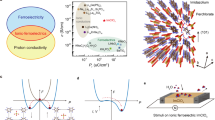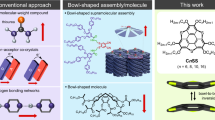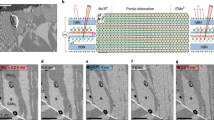Abstract
Materials exhibiting a spontaneous electrical polarization1,2 that can be switched easily between antiparallel orientations are of potential value for sensors, photonics and energy-efficient memories. In this context, organic ferroelectrics3,4 are of particular interest because they promise to be lightweight, inexpensive and easily processed into devices. A recently identified family of organic ferroelectric structures is based on intermolecular charge transfer, where donor and acceptor molecules co-crystallize in an alternating fashion known as a mixed stack5,6,7,8: in the crystalline lattice, a collective transfer of electrons from donor to acceptor molecules results in the formation of dipoles that can be realigned by an external field as molecules switch partners in the mixed stack. Although mixed stacks have been investigated extensively, only three systems are known9,10 to show ferroelectric switching, all below 71 kelvin. Here we describe supramolecular charge-transfer networks that undergo ferroelectric polarization switching with a ferroelectric Curie temperature above room temperature. These polar and switchable systems utilize a structural synergy between a hydrogen-bonded network and charge-transfer complexation of donor and acceptor molecules in a mixed stack. This supramolecular motif could help guide the development of other functional organic systems that can switch polarization under the influence of electric fields at ambient temperatures.
This is a preview of subscription content, access via your institution
Access options
Subscribe to this journal
Receive 51 print issues and online access
$199.00 per year
only $3.90 per issue
Buy this article
- Purchase on Springer Link
- Instant access to full article PDF
Prices may be subject to local taxes which are calculated during checkout






Similar content being viewed by others
References
Stupp, S. I. et al. Supramolecular materials: self-organized nanostructures. Science 276, 384–389 (1997)
Horiuchi, S., Okimoto, Y., Kumai, R. & Tokura, Y. Quantum phase transition in organic charge-transfer complexes. Science 299, 229–232 (2003)
Horiuchi, S. & Tokura, Y. Organic ferroelectrics. Nature Mater. 7, 357–366 (2008)
Horiuchi, S. et al. Above-room-temperature ferroelectricity in a single-component molecular crystal. Nature 463, 789–792 (2010)
Torrance, J. B., Vazquez, J. E., Mayerle, J. J. & Lee, V. Y. Discovery of a neutral-to-ionic phase-transition in organic materials. Phys. Rev. Lett. 46, 253–257 (1981)
Tokura, Y. et al. Domain-wall dynamics in organic charge-transfer compounds with one-dimensional ferroelectricity. Phys. Rev. Lett. 63, 2405–2408 (1989)
Collet, E. et al. Laser-induced ferroelectric structural order in an organic charge-transfer crystal. Science 300, 612–615 (2003)
Hamilton, D. G., Lynch, D. E., Byriel, K. A. & Kennard, C. H. L. A neutral donor-acceptor π-stack: solid-state structures of 1:1 pyromellitic diimide-dialkoxynaphthalene cocrystals. Aust. J. Chem. 50, 439–445 (1997)
Kobayashi, K. et al. Electronic ferroelectricity in a molecular crystal with large polarization directing antiparallel to ionic displacement. Phys. Rev. Lett. 108, 237601 (2012)
Kagawa, F. et al. Electric-field control of solitons in a ferroelectric organic charge-transfer salt. Phys. Rev. Lett. 104, 227602 (2010)
Torrance, J. B. et al. Anomalous nature of neutral-to-ionic phase-transition in tetrathiafulvalene-chloranil. Phys. Rev. Lett. 47, 1747–1750 (1981)
Girlando, A., Marzola, F., Pecile, C. & Torrance, J. B. Vibrational spectroscopy of mixed stack organic semiconductors — neutral and ionic phases of tetrathiafulvalene chloranil (TTF-CA) charge-transfer complex. J. Chem. Phys. 79, 1075–1085 (1983)
Okamoto, H. et al. Anomalous dielectric response in tetrathiafulvalene-para-chloranil as observed in temperature-induced and pressure-induced neutral-to-ionic phase-transition. Phys. Rev. B 43, 8224–8232 (1991)
Soos, Z. G. Identification of dimerization phase transitions driven by Peierls and other mechanisms. Chem. Phys. Lett. 440, 87–91 (2007)
Girlando, A., Pecile, C. & Torrance, J. B. A key to understanding ionic mixed stacked organic-solids — tetrathiafulvalene-bromanil (TTF-BA). Solid State Commun. 54, 753–759 (1985)
McKinnon, J. J., Spackman, M. A. & Mitchell, A. S. Novel tools for visualizing and exploring intermolecular interactions in molecular crystals. Acta Crystallogr. B 60, 627–668 (2004)
Crystal Explorer v.2.1 (Univ. Western Australia, Perth, 2007); available at http://hirshfeldsurface.net/
Kuwata-Gonokami, M. et al. Exciton strings in an organic charge-transfer crystal. Nature 367, 47–48 (1994)
Meneghetti, M. & Pecile, C. TTF-TCNE a charge transfer π-molecular crystal with partial ionic ground state: optical properties and electron-molecular vibrations interaction. J. Chem. Phys. 105, 397–407 (1996)
Miyajima, D. et al. Ferroelectric columnar liquid crystal featuring confined polar groups within core–shell architecture. Science 336, 209–213 (2012)
Zhang, Q. M., Bharti, V. & Zhao, X. Giant electrostriction and relaxor ferroelectric behavior in electron-irradiated poly(vinylidene fluoride-trifluoroethylene) copolymer. Science 280, 2101–2104 (1998)
Torrance, J. B. The difference between metallic and insulating salts of tetracyanoquinodimethone (TCNQ): how to design an organic metal. Acc. Chem. Res. 12, 79–86 (1979)
Brøndsted Nielsen, M., Hansen, J. G. & Becher, J. Self-complexing tetrathiafulvalene-based donor–acceptor macrocycles. Eur. J. Org. Chem. 1999, 2807–2815 (1999)
Saha, S. et al. A photoactive molecular triad as a nanoscale power supply for a supramolecular machine. Chem. Eur. J. 11, 6846–6858 (2005)
Acknowledgements
This work was supported by the Non-equilibrium Energy Research Center (NERC) at Northwestern University, funded by the US Department of Energy (DOE), Office of Basic Energy Sciences under award number DE-SC0000989. A.K.S. received support from the Materials Research Science and Engineering Centre (MRSEC) at Northwestern University, funded by the National Science Foundation (NSF). D.C., A.C.F. and J.F.S. were supported by the WCU program (R-31-2008-000-10055-0) at KAIST in Korea. Use of the Center for Nanoscale Materials was supported by the US Department of Energy, Office of Science, Office of Basic Energy Sciences, under contract no. DE-AC02-06CH11357. D.C. and A.C.F. were supported by NSF Graduate Research Fellowships. A.K.S. and A.C.-H.S. were supported by a fellowship from the NERC. A.S.T. was supported by a fellowship from the Initiative for Sustainability and Energy at Northwestern (ISEN) and NERC. We thank J. B. Ketterson and O. Chernyashevskyy (Northwestern University) for discussions and advice, Y. D. Shah (Northwestern University) for assistance with ferroelectricity measurements, A. M. Z. Slawin (University of St Andrews) for initial help with crystallographic data collection and refinement, M. Mara (Northwestern University) for assistance with spectroscopy, Y. Liu (The Molecular Foundry, Lawrence Berkeley National Laboratory) for discussions, and the Integrated Molecular Structure Education and Research Centre (IMSERC) and the Magnet and Low Temperature Facility at Northwestern University for providing access to equipment for the relevant experiments. Molecular crystal images were produced using the UCSF Chimera package from the Resource for Biocomputing, Visualisation and Informatics at the University of California, San Francisco.
Author information
Authors and Affiliations
Contributions
A.S.T., A.K.S. and A.C.-H.S. conceived and designed the LASO networks. A.K.S., A.C.-H.S., D.C. and S.K.D. synthesized the compounds studied in this work; A.S.T., T.J.K. and W.W. performed device fabrication and testing; A.K.S., J.M.S. and B.R. performed spectroscopic studies. C.L.S. and A.A.S. collected crystallography data, and A.A.S. and A.K.S. performed crystal structure refinement; A.C.F. performed cyclic voltammetry experiments; J.R.G. helped with magnetic force microscopy experiments; H.M. provided testing equipment; J.F.S., S.I.S., L.X.C. and K.L.W. offered intellectual input; A.S.T., A.K.S., A.C.-H.S., J.F. S. and S.I.S. wrote the manuscript.
Corresponding authors
Ethics declarations
Competing interests
The authors declare no competing financial interests.
Supplementary information
Supplementary Information
This file contains Supplementary Text, Supplementary Figures 1-24, Supplementary Tables 1-3 and Supplementary References. (PDF 8422 kb)
Supplementary Data
This zipped file contains 3 data files. Crystallographic Information File 1 is the Crystallographic Information File (CIF) for the supramolecular network 1·2. Crystallographic Information File 2 is the Crystallographic Information File (CIF) for the supramolecular network 1·3 and Crystallographic Information File 3 is the Crystallographic Information File (CIF) for the supramolecular network 1·4. (ZIP 24 kb)
Rights and permissions
About this article
Cite this article
Tayi, A., Shveyd, A., Sue, AH. et al. Room-temperature ferroelectricity in supramolecular networks of charge-transfer complexes. Nature 488, 485–489 (2012). https://doi.org/10.1038/nature11395
Received:
Accepted:
Published:
Issue Date:
DOI: https://doi.org/10.1038/nature11395
This article is cited by
-
Chalcogen-bridged coordination polymer for the photocatalytic activation of aryl halides
Nature Communications (2023)
-
Grinding-induced supramolecular charge-transfer assemblies with switchable vapochromism toward haloalkane isomers
Nature Communications (2023)
-
Organic radical ferroelectric crystals with martensitic phase transition
Nature Communications (2023)
-
DFT calculations predict that inverted geometries at carbon can be stabilized within multi-component co-crystals
Theoretical Chemistry Accounts (2023)
-
Biferroelectricity of a homochiral organic molecule in both solid crystal and liquid crystal phases
Nature Communications (2022)
Comments
By submitting a comment you agree to abide by our Terms and Community Guidelines. If you find something abusive or that does not comply with our terms or guidelines please flag it as inappropriate.



